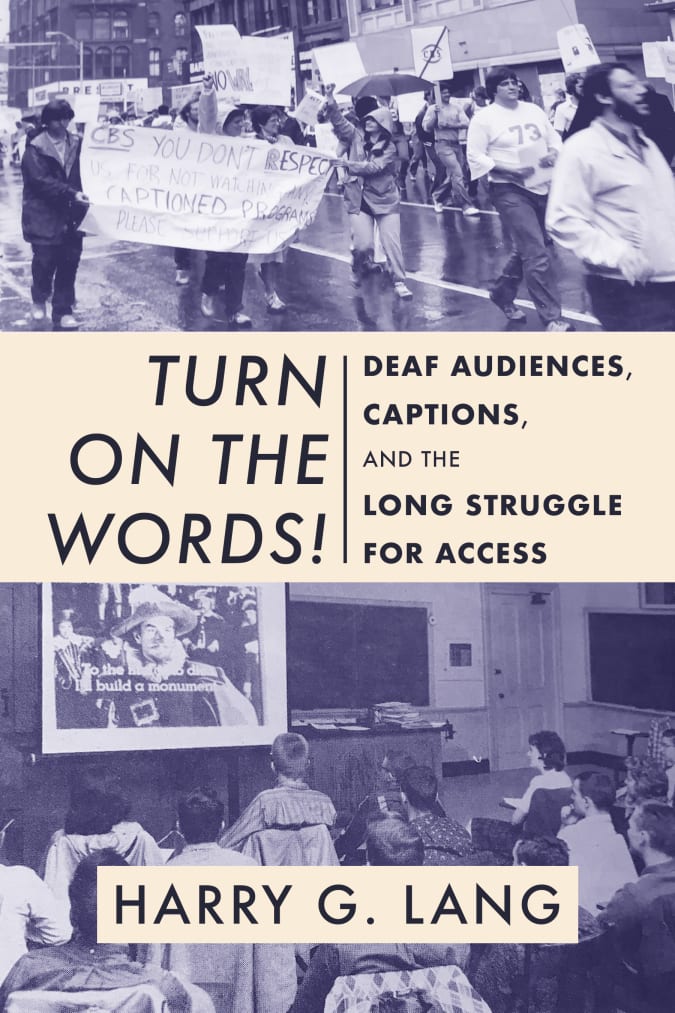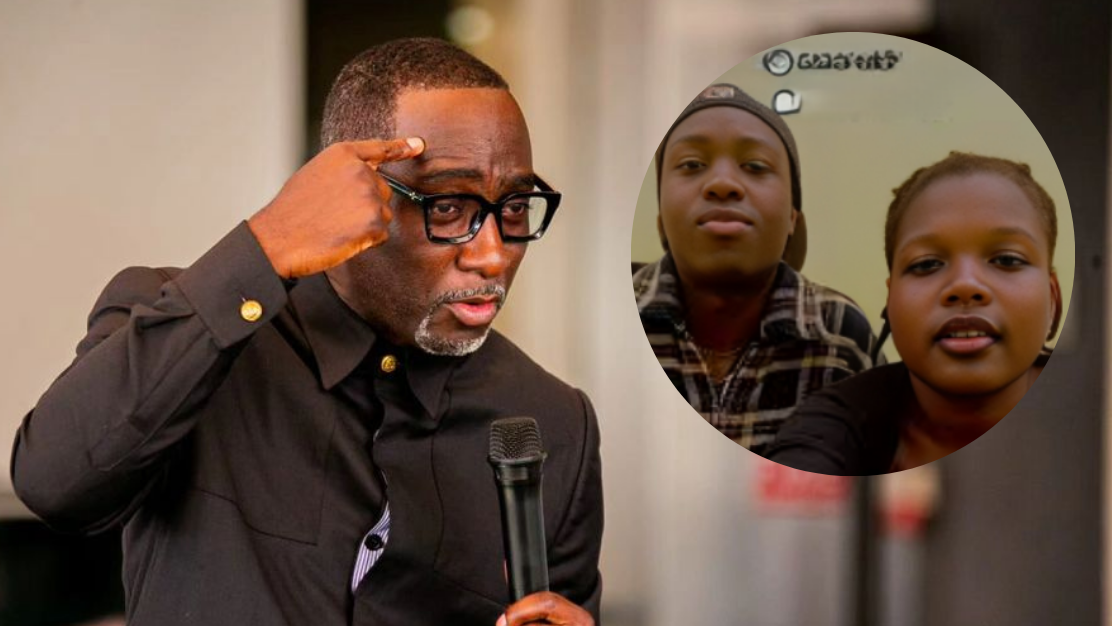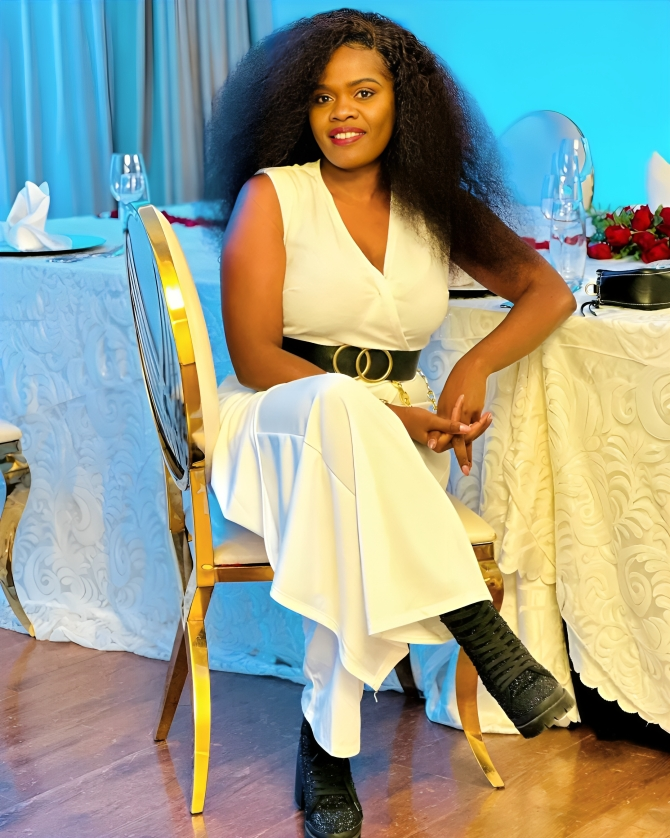The Silent Era of cinema was perhaps its most equitable with both hearing and hearing-impaired viewers able to enjoy productions alongside one another, but with the advent of “talkies,” deaf and hard-of-hearing American’s found themselves largely excluded from this new dominant entertainment medium. It wouldn’t be until the second half of the 20th century that advances in technology enabled captioned content to be broadcast directly into homes around the country. In his latest book, Turn on the Words! Deaf Audiences, Captions, and the Long Struggle for Access, Professor Emeritus, National Technical Institute for the Deaf at Rochester Institute of Technology, Harry G. Lang, documents the efforts of accessibility pioneers over the course of more than a century to bring closed captioning to the American people.

Gallaudet University Press
From Turn on the Words! Deaf Audiences, Captions, and the Long Struggle for Access by Harry G. Lang. Copyright © 2021 by Gallaudet University. Excerpted by permission.
The Battle for Captioned Television
To the millions of deaf and hard of hearing people in the United States, television before captioning had been “nothing more than a series of meaningless pictures.” In 1979, Tom Harrington, a twenty-eight-year old hard of hearing audiovisual librarian from Hyattsville, Maryland, explained that deaf and hard of hearing people “would like to watch the same stuff as everyone is watching, no matter how good or how lousy. In other words, to be treated like everyone else.”
On March 16, 1980, closed captioning officially began on ABC, NBC, and PBS. The first closed captioned television series included The ABC Sunday Night Movie, The Wonderful World of Disney, and Masterpiece Theater. In addition, more than three decades after the movement to make movies accessible to deaf people began, ABC officially opened a new era by airing its first closed captioned TV movie, Force 10 from Navarone.
By the end of March 1980, sixteen captioned hours of programming were going out over the airwaves each week, and by the end of May, Sears had sold 18,000 of the decoding units within four months of offering them for sale. Sears gave NCI an $8 royalty for each decoding device sold. The funds were used to defray the costs of captioning. In addition to building up a supply of captioned TV programs during its first year of operation, so that a sufficient volume would be available for broadcast, NCI concentrated on training caption editors. A second production center was established in Los Angeles and a third in New York City.
John Koskinen, chairman of NCI’s board, reflected on the challenges the organization faced at this time. A much smaller market for the decoders was evident than that estimated through early surveys. As with the telephone modem that was simultaneously developing, the captioning decoders cost a significant sum for most deaf consumers in those days, and the expense of a decoder did not buy a lot because not all the captioned hours being broadcast were of interest to many people. Although the goal was to sell 100,000 decoders per year, NCI struggled to sell 10,000, and this presented a financial burden.
To help pay for the captioning costs, NCI also set up a “Caption Club” to raise money from organizations serving deaf people and from other private sources. By December 1983, $15,000 was taken in and used to pay for subtitles on programs that otherwise would not be captioned. By 1985, there were 3,500 members promoting the sales.
Interestingly, when sales suddenly went up one year, NCI investigated and found that the Korean owner of an electronics store in Los Angeles was selling decoders as a way to enhance English learning.
The next big breakthrough was the move toward the use of digital devices recently adopted by court recorders that, for NCI, allowed the captioning of live television. Having the ability to watch the evening news and sporting events with captions made the purchase of a decoder more attractive, as did the decline in its price over time.
When the American television network NBC showed the twelve hour series Shogun in 1980, thousands of deaf people were able to enjoy it. The $20 million series was closed captioned and 30,000 owners of the special decoder sets received the dialogue.
Jeffrey Krauss of the FCC admitted that deaf people had not had full access to television from the very beginning: “But by early 1980 it should be possible for the deaf and [hard of hearing] to enjoy many of the same programs we do via a new system called ‘closed captioning.’” Sigmond Epstein, a deaf printer from Annandale, Virginia, felt that “there is more than a 100 percent increase in understanding.” And Lynn Ballard, a twenty-five-year-old deaf student from Chatham, New Jersey, believed that closed captioning would “improve the English language skills and increase the vocabulary of deaf children.” Newspaper reports proliferated, describing the newfound joy among deaf people in gaining access to the common television. Educators recognized the technological advance as a huge leap forward. “I consider closed captioning the single most important breakthrough to give the deaf access to this vital medium,” said Edward C. Merrill Jr., president of Gallaudet College, adding presciently, “Its usage will expand beyond the hearing-impaired.” And an ex-cop cried when his deaf wife wept for joy at understanding Barney Miller. He wrote a letter to the TV networks, cosigned by their six small children, to tell of the new world of entertainment and learning now open to his wife.
3-2-1 Contact was among the first group of television programs, and the first children’s program, to be captioned in March 1980. This science education show produced by Children’s Television Workshop aired on PBS member stations for eight years. Later that same year, Sesame Street became the second children’s program to be captioned and became the longest running captioned children’s program. — “NCI Recap’d,” National Captioning Institute
The enthusiasm continued to spread swiftly among deaf people. Alan Hurwitz, then associate dean for Educational Support Services at NTID, and his family were all excited about the captioning of primetime television programs. Hurwitz, who would eventually be president of Gallaudet University, was, like everyone else at this time, hooked on the new closed captioning technology. One of his favorite programs in 1981 was Dynasty, which was shown weekly on Wednesday night at 9 p.m. He flew to Washington, DC, early one Wednesday morning to meet with congressional staff members in different offices all day long. Not having a videotape recorder, he made sure he had scheduled a flight back home in time to watch Dynasty. After the meetings he arrived at the airport on time only to find out that the plane was overbooked and he was bumped off and scheduled for a flight the next morning. He panicked and argued with the airline clerk that he had to be home that night, and stressed that he couldn’t miss the flight. He was put on a waiting list and there were several folks ahead of him. Then, when he learned that he would definitely miss the flight, he went back to the clerk and insisted that he get on the plane. He explained that he had no way to contact his wife and was concerned about his family. Finally, the clerk went inside the plane and asked if anyone would like to get off and get a reward for an additional flight at no cost. One passenger volunteered to get off and Hurwitz was allowed to take his seat. The plane left a bit late and arrived in Rochester barely in time for him to run to his car in the parking lot and drive home to watch Dynasty!
And even with the positive response from many consumers, it was reported in 1981 that the Sears TeleCaption decoders were not selling well. It was a catch-22 situation. “People hesitate to buy because more programs aren’t captioned; more programs aren’t captioned because not that large an audience has adapters.” Increasing one would clearly increase the other. The question was whether to wait for “the other” to happen. To do so would most likely endanger a considerable federal investment as well as the continued existence of the system. Some theorized that the major factors for the poor sale of decoders were the depressed state of the economy, the lack of a captioned prime-time national news program (which deaf and hard of hearing people cited as a top priority), insufficient numbers of closed captioned programs, and an unrealistic expectation by some purchasers that decoder prices would decrease in spite of the fact that the retailer markup was slightly above the actual production cost.
Captioning a TV Program: A Continuing Challenge
On average, it took twenty-five to forty hours to caption a one-hour program. First, the script was typed verbatim, including every utterance such as “uh,” stuttering, and so forth. Asterisks were inserted to indicated changes in speakers. Next, the time and place of the wording was checked in the program. The transcript was examined for accuracy, noting when the audio starts and stops, and then it was necessary to decide whether the captions should be placed on the left, right, or center of the screen. In 1981, NCI’s goal was to provide no more than 120 to 140 reading words per minute for adult programs and sixty to ninety for children’s programs.
“We have to give time for looking at the picture,” Linda Carson, manager of standards and training at NCI, explained. “A lot of TV audio goes up to 250 or 300 words per minute. That’s tough for caption writers. If the time lapse for a 15-word sentence is 4 ½ seconds, then the captioner checks the rate computation chart and finds out she’s got to do it in nine words.”
Carl Jensema, NCI’s director of research, who lost his hearing at the age of nine, explained that at the start of kindergarten, hearing children have about 5,000 words in their speaking vocabulary, whereas many deaf children are lucky to have fifty. Consequently, deaf children had very little vocabulary for the school to build on. Jensema believed that closed captioning might be the biggest breakthrough for deaf people since the hearing aid. He was certain that a high degree of exposure to spoken language through captioned television was the key to enhanced language skills in deaf people.
CBS Resists
Although ABC, PBS, and NBC were involved in collaborating with NCI to bring captions to deaf audiences, the system CBS supported, teletext, was developed in the United Kingdom and was at least three years away from implementation. “It seems to me that CBS, by not going along with the other networks, might be working in derogation of helping the deaf or the hearing-impaired to get this service at an earlier date—and I don’t like it.” FCC commissioner Joseph Fogarty told Gene Mater, assistant to the president of the CBS Broadcast Group. Despite the success of line 21 captioning, CBS’s Mater believed the teletext system was “so much better” and the existing system was “antiquated.” “I think what’s unfortunate is that the leadership of the hearing-impaired community has not seen fit to support teletext. Those people who have seen teletext recognize it as a communications revolution for the deaf.” In contrast, NCI’s Jeff Hutchins summarized that the World System Teletext presented various disadvantages. It could not provide real-time captioning, “at least not in the way we have seen it . . .” Also, it could not work with home videotape. He believed that even if World System Teletext were adopted by the networks and other program suppliers, the technology would not be an answer for the needs of the American Deaf community. He also explained that “too many services now enjoyed by decoder owners would be lost.”
CBS even petitioned the FCC in July 1980 for a national teletext broadcasting standard. Following this, the Los Angeles CBS affiliate announced plans to test teletext in April 1981. “CBS was so opposed to line 21 that even when advertisers captioned their commercials at no charge to CBS,” Karen Peltz Strauss wrote, “the network allegedly promised to strip the captions off before airing the ads.”
CBS continued its refusal to join the closed captioning program, largely because of its own research into the teletext system and because the comparatively low number of adapters purchased. The NAD accused CBS of failing to cooperate with deaf television viewers by refusing to caption its TV programs.
The NAD planned nationwide protests shortly after this. Hundreds of captioning activists gathered at studios around the country. In Cedar Rapids, one young child carried a sign that read, “Please caption for my Mom and Dad.” Gertie Galloway was one of the disappointed deaf consumers. “CBS has not cooperated with the deaf community,” she stated. “We feel we have a right to access to TV programs.” She was one of an estimated 300 to 400 people carrying signs, who marched in front of the CBS studio in Washington and who were asking supporters to refuse to watch CBS for the day. Similar demonstrations were held in New York, where there were 500 people picketing, and the association said that protests had been scheduled in the more than 200 communities where CBS had affiliates.
Harold Kinkade, the Iowa Association of the Deaf vice president, said, “I don’t think deaf people are going to give up on this one. We always fight for our rights to be equal with the people with hearing.”
The drama increased in August 1982 when it was announced that NBC was dropping captions due to decreased demand. It was two years after NBC had become a charter subscriber. John Ball, president of NCI, said, “There is no question that this hurts. This was a major revenue source for NCI. I think the next six months or so are going to be crucial for us.”
Captioning advocates included representatives from NTID, the National Fraternal Society of the Deaf, Gallaudet, and NAD. Karen Peltz Strauss tells the story of Phil Bravin, chair of a newly established NAD TV Access Committee, who represented the Deaf community in a meeting with NBC executives. Although the NBC meeting was successful, CBS was still resisting and Bravin persisted. As Strauss summarized, “After one particularly frustrating three-hour meeting with the CBS President of Affiliate Relations Tony Malara, Bravin left, promising to ‘see you on the streets of America.’”
In 1984, CBS finally gave in, and the network dual encoded its television programs with both teletext and line 21 captions. The issue with NBC also resolved, and by 1987 the network was paying a third of the cost of the prime-time closed captioning. The rest was covered by such sources as independent producers and NCI, with funds from the US Department of Education used for captioning on CBS and ABC as well.
In his book Closed Captioning: Subtitling, Stenography, and the Digital Convergence of Text with Television, Gregory J. Downey summarized that because the film industry was unwilling to perform same-language subtitling for its domestic audience, the focus of deaf and hard of hearing persons’ “educational and activist efforts toward media justice through subtitling in the 1970s and 1980s had decisively moved away from the high culture of film and instead toward the mass market of television.”
Meanwhile, teachers and media specialists in schools for deaf children across the United States were reporting that their students voluntarily watched captioned TV shows recorded on videocassettes over and over again. These youngsters were engaged in reading, with its many dimensions and functions. In the opinion of some educators, television was indeed helping children learn to read.
People at NCI looked forward to spin-offs from their efforts. They liked to point out that experiments on behalf of deaf people produced the telephone and that the search for a military code to be read in the dark led to braille. Closed captioning should be no different in that regard. The technology also showed promise for instructing hearing children in language skills. Fairfax County public schools in Virginia, authorized a pilot project to study the effectiveness of captioned television as a source of reading material. The study explored the use of closed captioned television in elementary classrooms, evaluated teacher and student acceptance of captioning as an aid to teaching reading, and served as a guide to possible future expansion of activities in this area. Instead of considering television as part of the problem in children’s declining reading and comprehension skills, Fairfax County wanted to make it part of the solution. Promising results were found in this study as well as in other NCI-funded studies with hearing children, and when NCI’s John Ball submitted his budget request to Congress for fiscal year 1987 he was citing “at least 1,500,000 learning disabled children” as a potential audience for captioning and the market for decoder purchases.
In a personal tribute to Carl Jensema, Jeff Hutchins wrote that the only aspect of NCI that really made it an “institute” was the work Carl did to research many different aspects of captioning, including its readability and efficacy among consumers. His work led to a revision of techniques, which made captioning more effective. Once Carl left NCI and the research department was shut down, NCI was not really an “institute” any longer. John Ball also believed in the importance of Jensema’s research at NCI. His studies clearly demonstrated the impact of captioning on NCI’s important audience.
Real-Time Captioning
As early as 1978, the captioning program began to fund developmental work in real-time captioning with the objective of making it possible to caption live programs, such as news, sports, the Academy Awards, and space shuttle launches. This developmental work, however, did not result in the system finally being used. The Central Intelligence Agency (CIA) was exploring a system that would allow the spoken word to appear in printed text. As it turned out, a private concern resulted from the CIA project, Stenocomp, which marketed computer translations to court reporters. The Stenocomp system relied on a mainframe computer and was thus too cumbersome. However, when Stenocomp went out of business, a new firm developed—Translation Systems, Inc. (TSI) in Rockville, Maryland. Advances in computer technology made it possible to install the Stenocomp software into a minicomputer. This made it possible for the NCI to begin real-time captioning using a modified stenotype machine linked to a computer via a cable.
On December 20, 1982, the Ninety-Seventh Congress passed a joint resolution authorizing President Ronald Reagan to proclaim December as “National Close-Captioned Television Month.” The proclamation was in recognition of the NCI service that made television programs meaningful and understandable for deaf and hard of hearing people in the United States.
By 1982, NCI was applying real-time captioning to a variety of televised events, including newscasts, sports events, and other live broadcasts, bringing deaf households into national conversations. The information, with correct punctuation, was brought to viewers through the work of stenographers trained as captioners typing at speeds of up to 250 words per minute. Real-time captioning was used in the Supreme Court to allow a deaf attorney, Michael Chatoff, to understand the justices and other attorneys.
However, fidelity was not the case for many years on television, and problems existed with real-time captioning. In real-time captioning, an individual typed the message into an electric stenotype machine, similar to those used in courtrooms, and the message included some shorthand. A computer translated the words into captions, which were then projected on the screen. Because “this captioning occurred ‘live’ and relies on a vocabulary stored in the software of the computer, misspellings and errorscould and did occur during transcriptions.”
Over the years, many have worked toward error reduction in realtime captioning. As the Hearing Loss Association of America has summarized, “Although real-time captioning strives to reach 98 percent accuracy, the audience will see errors. The caption writer may mishear a word, hear an unfamiliar word, or have an error in the software dictionary. In addition, transmission problems can create technical errors that are not under the control of the caption writer.”
At times, captioners work in teams, similar to some sign language interpreters, and provide quick corrections. This was the approach the pioneer Martin Block used during the Academy Awards in April 1982. Block typed the captions while a team of assistants provided him with correct spellings of the award nominees.
There has also been a growing body of educational research supporting the benefits of captions. As one example, E. Ross Stuckless referred to the concept of real-time caption technology in the early 1980s as the “computerized near-instant conversion of spoken English into readable print.” He also described the possibility of using real-time captioning in the classroom. Michael S. Stinson, another former colleague of mine and also a deaf research faculty member at NTID at RIT, was involved with Stuckless in the first implementation and evaluation of real-time captioning as an access service in the classroom. Stinson subsequently obtained numerous grants to develop C-Print access through real-time captioning at NTID, where hundreds of deaf and hard of hearing students have benefited in this postsecondary program. C-Print also was found successful in K–12 programs.
Communication Access Real-Time Translation (CART) is another service provided in a variety of educational environments, including small groups, conventions, and remote transmissions to thousands of participants viewing through streaming text. Displays include computers, projection screens, monitors, or mobile devices, or the text may be included on the same screen as a PowerPoint presentation.
Special approaches have been used in educational environments. For example, at NTID, where C-Print was developed by Stinson, the scripts of the classroom presentations and communication between professors and students are printed out, and errors are corrected and given to the students to study.
In October 1984, ABC’s World News This Morning became the first daytime television program to be broadcast to viewers with decoders through real-time captioning technology. Within a few weeks, the ABC’s Good Morning America was broadcast with captions as well. “This is a major milestone in the evolution of the closed-captioned television service,” John E. D. Ball declared, describing it as a “valued medium” to deaf and hard of hearing viewers. Don Thieme, a spokesman for NCI, explained that the Department of Education had provided The Caption Center with a $5.3 million contract. These two programs joined ABC’s evening news program World News Tonight and the magazine show 20/20 as the only regularly scheduled news and public affairs available for deaf viewers. The captioned news programs would be phased in gradually during the summer and early fall. Real-time captioning was also provided for the presidential political debates around this time. More than sixty-five home video movies had also been captioned for deaf people. This was an important step toward providing more access to entertainment movies for deaf consumers.
The first time the Super Bowl was aired with closed captions was on January 20, 1985. In September 1985, ABC’s Monday Night Football became the first sports series to include real-time captioning of commentary. ABC, its affiliates, the US Department of Education, advertisers, corporations, program producers, and NCI’s Caption Club helped to fund this program. Using stenotype machines, speed typists in Falls Church, Virginia, listened to the telecast and produced the captions at about 250 words per minute and they appeared on the screen in about four seconds. Each word was not typed separately. Instead, the captioner stroked the words out phonetically in a type of shorthand. Then a computer translated the strokes back into the printed word. These words were sent through phone lines to the ABC control room in New York City, where they were added to the network signal and transmitted across the country. Darlene Leasure, who was responsible for football, described one of the challenges she encountered: “When I was programming my computer at the beginning of the season, I found thirteen Darrels with seven different spellings in the NFL. It’s tough keeping all those Darrels straight.”
As TV shows with closed captions grew in popularity, deaf people were attracted away from the captioned film showings at social clubs or other such gatherings. The groups continued to hold their meetings, but for most gatherings the showing of captioned films gradually stopped. At the same time, telecommunications advances had brought telephone access to deaf people and there was less need for face-to-face “live” communication. Together, the visual telecommunications and captioned television technologies profoundly impacted the way deaf people interacted.
All products recommended by Engadget are selected by our editorial team, independent of our parent company. Some of our stories include affiliate links. If you buy something through one of these links, we may earn an affiliate commission.
Note: This article have been indexed to our site. We do not claim legitimacy, ownership or copyright of any of the content above. To see the article at original source Click Here








